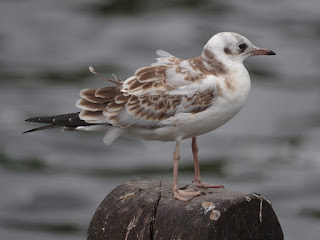... and taking them to the railings, where they briefly chewed them and then dropped them before going back for another flower.
On a grey day of intermittent drizzle with little happening, it was pleasing to get another shot of a young Reed Warbler in the reed bed at the Diana fountain. A parent had just whizzed across the path to look for insects in the adjacent flower bed, and the young bird was waiting for it to come back.
There was no sign of a Little Owl in the usual oak tree, and I was about to give up when there was a call from the next tree, the one where the pair originally nested. This is the male owl.
A Grey Heron stood on the railings of the Lido swimming area, hoping to see a fish in the shallow water.
A young Black-Headed Gull at Peter Pan turned downwind and got its feathers ruffled.
The usual Mallard with five ducklings was here. They are now strapping teenagers.
There are four new Mallard ducklings at the island.
The dark Mallard brothers ignored the rain. They must be going into eclipse, but don't look any different.
These are some of the young Greylag Geese which have appeared on the Serpentine, both hatched here and flown in from elsewhere. They have yellower bills and feet than adults, no white line along the bottom edge of their folded wings, and a slightly softer general look.
The number of recently arrived Great Crested Grebes on the Serpentine has gone up to nine: seven adults and two teenagers. They are still all staying together in a loose cluster, as grebes do when they have just flown in and not started establishing territories. I managed to get seven of them into this picture.
The chick at the island was going around with one parent, while the other sat on the nest.
These Coot chicks under the marble fountain in the Italian Garden were first seen on 1 July, so they are about a month old. Their parents are no longer feeding them, but the family stays together.
The nest at the Serpentine outflow, the fifth to be built her this year, had been unoccupied for a couple of days but is now back in service.
The nest at the Dell restuarant, still in use although the chicks are almost grown up, was decorated with a pair of sunglasses.
The new Moorhen family in the Italian Garden was nowhere to be seen, but an adult and a chick were eating duckweed in the lake below. They are probably the same ones. They were having to share a pool with a pair of belligerent Coots, a good reason for leaving.
The Moorhens in the hawthorn at the Dell restaurant must be nesting again. One stood on a table holding a larva before flying up into the tree.















I went by the hornbeam today and the damage was staggering. Three other hornbeams in the group had similar but older carpets of flowers under them, which I was inclined to put down to natural processes until I saw your parakeet pictures today. Is it possible they too were trashed by the parakeets?
ReplyDeleteI also revisited the place and had the same thought. Curiously, the tree just up the hill from the newly damaged one seems almost untouched.
DeleteRose-Ringed Parakeets are a real blight. There is talk of culling them here on account of all the damage they do to habitats and local birds.
ReplyDeleteThe Coot looks mighty proud of its decorative genius. Who would have thought an old pair of glasses could become art (I am sure that if some modern artist were to sell the Coot's nest as an art installation most galleries would go ga ga over it).
How much has the Grebe chick need to grow to have a chance? How many more days?
Perhaps we could carefully remove the nest and enter it for the Turner Prize.
DeleteWe have a winner.
Delete...intriguing.... which suggests it's the parakeets that are responsible and not natural processes? On the grounds that if it were natural shedding the trees would tend to be doing it at the same time?
ReplyDeleteAbsolutely the parakeets, not a doubt about it. And not just hornbeams, anything with buds or flowers that they find palatable.
Delete